|
| We all do it.
We try not to notice the funny noise the car has started making, or
we try to think it’s our imagination when the refrigerator doesn’t
seem as cool as it used to be, and we want to think that the drip
under our water heater is just a leaky valve. I should have recognized
the warning signs when I drove up to Walter’s house, and the first
thing he said to me was, “Got anything to kill rattlesnakes with?”
Followed by, “You carry a water bottle? I don’t go anywhere without
a bottle of water.” My biggest clue for what I was in for was when
he asked if I had ever ridden on a 4-wheeler. I knew it was too late
when he said, “Here’s a cushion for you.” |
The
"Buried Here" Texas Centennial Marker
Photo courtesy Barclay
Gibson, 2010 |
What sparked
this interest I have in trying to locate the roughly one thousand
old granite Texas Centennial
Markers that were put in place all over the state back in 1936?
I can’t say for sure. What could be easier than driving up to a historical
marker beside the road and snapping a few pictures? Nothing to it.
A lot of historical markers are like that. But one that has been the
hardest, so far, to even be sure it existed, was the Young County
“Buried Here” marker. It might also be called the “Teamsters”
or “Warren Wagon Train Massacre” marker.
Buried Here; those are the first words engraved on the marker itself
and often designates the marker’s title. Searching several websites
that specialize in historical markers didn’t turn up anything. The
1938 book published by
the Texas Centennial Commission doesn’t have this listing in its
index, nor does the Texas Historical Commission have a page for it.
Some local historians have heard of it. After several months of phone
calls and searching the internet, I finally found one single picture
of the marker. This was the first clue that the marker really existed.
I called the photographer, also a local historian, and after grilling
me as to who I was, whom I represented, and why I wanted to see the
marker, refused to either tell me where it was or give me a phone
number of someone who would. He deemed me too much of a novice, and
I was unqualified to even see it. |
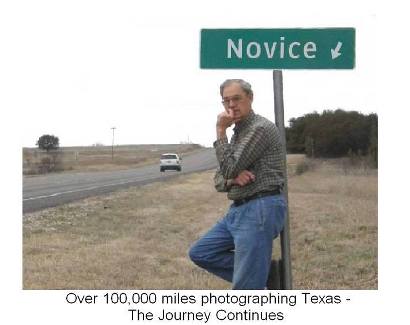 |
This was a real
setback for me. Why did I want to see it? Now I wanted to see it even
more. I decided to make one more phone call. This time a very nice
lady gave me a phone number; I called it and was given another number.
That was my first contact with Walter. There was no quizzing or hesitation,
just “When are you coming?” He doesn’t own the property where the
marker is located but has permission to go there. When he asked me
about the rattlesnakes, I thought, well, on all Texas
road trips I always carry extra fuel, two spares, three jacks,
a shovel, first aid kit, cell phone, bed roll, and even bug spray
in case my flat is in the middle of an ant bed. But I have nothing
effective against rattlesnakes except for high top boots, which I
immediately put on. I thought I would follow him to the marker in
my truck and be on my way in fifteen minutes.
Walter said he would drive and to get in with him. I told him how
much I appreciated him taking his time to show me the marker. He commented
that he was seventy-six years old and had nothing else to do. Judging
from the immaculate condition of his house, lawn and surroundings,
I knew he had plenty to do, and he was always busy. Tropical Storm
Hermine had just left the area and had dropped several inches of rain
on her way to Oklahoma. We took off and headed down the road.
The first thing he showed me was the aluminum historical marker set
out on the highway commemorating the death of the seven wagon teamsters
back in 1871. Often these markers serve as available replacements
for the granite markers that are inaccessible. |
Warren
Wagon Train Massacre Historical Marker
Hwy 16, 8 Miles NE of Graham
|
Warren Wagon
Train Massacre
On Salt Creek Prairie
(1.5 mi. W), On May 18,1871, Kiowas and Comanches from the Fort Sill
Reservation, in present Oklahoma, attacked a train of 12 wagons owned
by Capt. Henry Warren, contractor of supplies for U.S. forts in this
frontier region. Seven teamsters were killed. The chiefs who led the
raid were soon arrested, and Satank committed suicide. In a nationally
spotlighted trial at Jacksboro,
Satanta spoke with great eloquence on behalf of his people. Texas'
Governor, E. J. Davis, later commuted the death sentences given by
the court. |
Next, we drove
into his son’s place. It had a very nice house and several barns.
Walter noted that he and his wife had built it, and it is now his
son’s. Next door was the house where Walter grew up, and where his
granddaughter now lives with her family. This is when he asked me
if I had ever ridden a four-wheeler. I sure am glad he thought to
bring cushions; I took them both. That passenger pipe rack on the
back of a four-wheeler would have left grid marks on me for days.
He grabbed two water bottles and his mini-oxygen tank, thanks to forty
years of smoking, put them in the handy tray and said, “Hop on.”
At this point I must confess that I am not a professional photographer,
but I like to go into an area in Texas,
whether it is a ghost
town, state park or a beautiful bypassed through-truss bridge,
take as many pictures
as possible, regardless of the sun or glare, and move on. My camera
is nothing fancy, and I refer to myself simply as a “drive-by photographer.”
I don’t carry a tripod or changeable lenses. Many of the accompanying
photographs were shot on the move from the back of the four-wheeler.
|
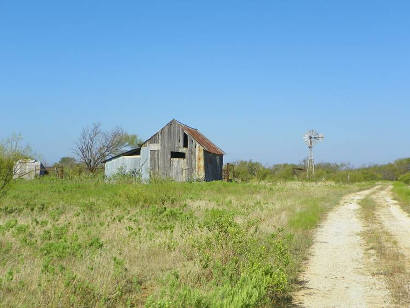 |
| Walter and I
took off out the back way, past an old barn and windmill, toward one
of the few hills in the area. We circled around to the north side
and started to climb. There are a lot of mesquite bushes in the area,
and we dodged a lot of low hanging branches. I kept expecting the
marker to come into view at any moment. The hill wasn’t very high,
but it sure gave us a commanding view because we were so much higher
than anything else around. We got to the top and hopped off. |
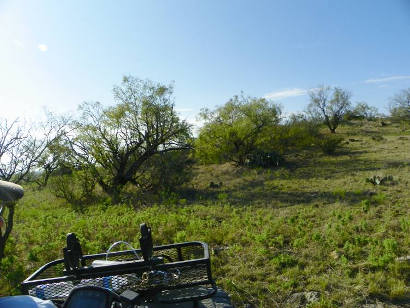 |
| Walter began
to explain this is where the Kiowas and Comanches from
the Fort Sill Reservation camped and were able to spy on any
activity in the area, particularly the Butterfield Stage Route
traffic between Fort
Richardson near Jacksboro
and Fort Griffin north
of Abilene. There
was another camp some distance to the northwest called Flat Top
Mountain, for a quite obvious reason. Whoever occupied these two
locations would be in control of the whole area. It was from this
first camp in May of 1871 that the Kiowas and Comanches attacked
a wagon train killing seven teamsters. The chiefs who led the raid
were put on trial, but that is another story. |
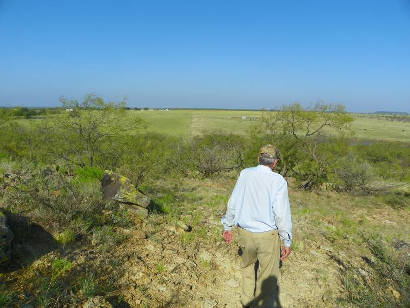 |
I was fully
expecting to see the marker nearby, but clearly it wasn’t. I asked
myself if this was all he was going to show me. Not wanting to appear
unappreciative, I asked him about it. He pointed off the southeast,
maybe two miles, and said it was near one of the pump jacks that the
haze almost obscured.
As Walter and I went back down the hill, we backtracked around to
the south and again turned toward the hill. At its base were the remains
of a very well laid rock foundation about six feet high. The second
floor of the house, now gone, was wooden and was entered from the
hill. It was what we would call a split-level house today. This house
was obviously built some time after Indians ceased to be a problem
in the area. He said that Loving and Goodnight
built dipping tanks for the cattle
in preparation of their drive
cattle north. A couple who lived in the house often took Walter fishing
many years ago.
I asked if we were going to see the marker now. He said yes, but that
we would take the pickup. Back at the barn I had to admit that my
first experience four-wheeling was a lot of fun. Walter handled the
four-wheeler very well and didn’t throw me off even once. Back in
his pickup, as we drove back to the highway, he asked me if I had
heard of Murphy Springs. Of course, I had not. It was a stage
stand for the Butterfield Trail. Fresh horses were ready for
the stage coaches as they passed through the area. He showed me its
approximate location. The wagon train never made it to the stand that
day. |
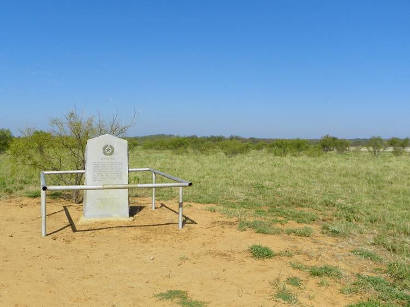 |
| Turning back
east down a dirt road, we came to a gate which was unlocked. Walter
noted that an oil field pumper was probably on the property checking
on oil wells. We drove in and sure enough here came the pumper. Walter
asked him to leave the gate unlocked, and we would lock it when we
left. At last, off to the right I could see the marker. Very often
these markers were just stuck in the ground without any concrete base,
and cattle liked to scratch their backs on them. Given rain soaked
soil and enough back rubbing, it was not uncommon for the 1,500 pound
marker to topple over. |
Another
view of the "Buried Here" Marker
Photo courtesy Barclay
Gibson, 2010 |
| Walter said this
one laid flat on the ground for many years until sometime in the 1970s
a group of men were able to get permission from the land owner to
stand it back up with a concrete base and build a protective pipe
fence around it. The marker looks every bit as good today as it did
the day it was delivered over seventy years ago. Even now the back
side has a soil stain that can’t be rubbed off from all those years
it laid in the dirt. |
| Walter and I
locked the gate on the way out, and he asked if I was in a hurry.
This was the last marker I had planned to see on this trip, so I had
plenty of time. We continued down the road, and he would tell me whose
property we were passing. We went past the place where his grandfather
had built his first house. The old barn is about gone, but the large
rock with the road number is still standing. |
Young
County History Tour Brass Marker
Photo courtesy Barclay
Gibson, 2010 |
Young
County History Tour Marker Text
Photo courtesy Barclay
Gibson, 2010 |
| Most of the roads
we had been on were dirt and gravel, but we came upon a place where
the water was still standing. He asked me what I thought. Here we
were, two men far from anywhere. Our total age was over 140 years
(you can figure pretty close to my age), and while I still like a
challenge, we knew it was best that to turn around. If we had gotten
stuck, we would have had a whole ‘nother story to tell. |
Jermyn
TX - First Methodist Church Closed
Photo courtesy Barclay
Gibson, 2010 |
Jermyn
TX First Methodist Church Marker
Photo courtesy Barclay
Gibson, 2010 |
| We came into
the small town of Jermyn,
and Walter said there was an old church off to the south. I had already
seen the church on a previous trip, but I would like to see it again.
We saw the old closed and abandoned church, slowly deteriorating.
I took several pictures of the outside and noticed one of the panels
of the front door missing. He wanted to go in. |
Jermyn
First Methodist Church Interior
Photo courtesy Barclay
Gibson, April 2010 |
| The sanctuary
looked just like it did when the last service ended. Everything was
same except for the accumulating water damage from the leaky roof.
The people just left and never came back. The song books were still
in the pews; the piano was still behind the pulpit, and the Sunday
School materials looked ready to be handed out. It is a sobering thought
about what is happening all over the country to small
town America. |
Jermyn
First Methodist Church Piano
Photo courtesy Barclay
Gibson, 2010 |
| By the time we
got back to his house, nearly three hours had past. It was time well
spent. Walter knew nothing about me when we first spoke. I only came
to see the old marker, but he wanted to make sure I knew what the
marker was all about. Thanks to Walter and his love for the area I
knew, at least a little more of the story of the Warren Wagon Train
Massacre. I couldn’t have gotten that from reading a roadside marker
for two minutes and driving on. |
One should never
ignore warning signs. In this case I am glad I embraced them. We didn’t
see or hear a single rattlesnake. We didn’t need the water or oxygen,
and I am really glad I took those cushions to sit on. Thank you, Walter,
for taking the time to put up with this “city guy” and showing him,
firsthand, a portion of what made this country so great.
© Barclay
Gibson October 1, 2010
See Barclay Gibson's
Texas
More Texas Centennial
|
| Texas
Escapes, in its purpose to preserve historic, endangered and vanishing
Texas, asks that anyone wishing to share their local history, stories,
landmarks and vintage or recent photos, please contact
us. |
|
|
